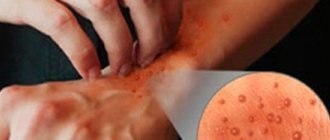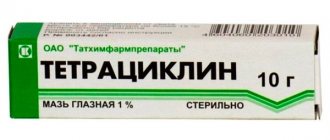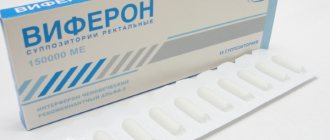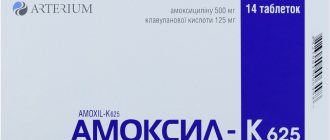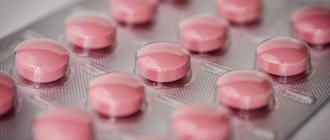Release form
Dexon is available in liquid and tablet form. One tablet contains 0.5 milligrams of dexamethasone. Packaging – blister of 10 pieces.
Injections
The solution is sealed in 2 milliliter ampoules, which corresponds to 8 milligrams of dexamethasone. The number of ampoules in the package is 6 pieces.
Drops
A dark glass bottle with a dropper included, 5 milliliters in volume, contains 5 milligrams of dexamethasone and 25 milligrams of neomycin. Percentage ratio in solution: dexamethasone – 0.1%; neomycin – 0.5%.
Pharmacological characteristics
Dexamethasone is a glucocorticosteroid, a synthetic hormone similar to adrenal enzymes. The anti-inflammatory effect is explained by blocking the conductors of inflammation and allergic reaction at the cellular level, reducing capillary permeability.
The ability to suppress the immune response reduces the reactivity of the body as a whole or locally when a pathological condition occurs.
Neomycin is an antimicrobial agent with bacteriostatic properties. It has an effect on gram-positive and gram-negative bacteria by suppressing the synthesis of protein cells. The combination of a hormone and an antibiotic enhances the anti-inflammatory effect.
Mechanism of action
The medicine has pronounced anti-inflammatory properties and helps cope with allergies. The substance leads to inhibition of histamine from mast cells. In addition, it has an effect on the source of inflammation and reduces its intensity.
Often, the product eliminates the manifestations of allergies - itching and burning sensation, swelling, tearing. Also, with the help of the drug it is possible to cope with spasms of the respiratory system, which are observed in bronchial asthma.
Due to the presence of neomycin in the composition, the medicine has an antibacterial effect. With its help, it is possible to cope with different strains of bacteria. Moreover, this result is achieved in the shortest possible time.
The injection medicine is available in the form of a solution. Each milliliter of the substance contains 4 mg of the active ingredient. The product is produced in glass ampoules of 2 ml each. There are usually 6 bottles in a cardboard package.
In what cases is it used
Dexon in tablet form is used:
- with inflammation of the joints;
- immunopathological reaction;
- bronchospasm in asthma;
- chronic inflammation of the large intestine;
- complications after streptococcal infection, affecting joints, heart valves, nervous system;
- skin lesions with itching, inflammation;
- impaired filtration capacity of the kidneys;
- malignant neoplasms.
Injections are prescribed to relieve severe conditions:
- in a state of shock for any reason (due to intoxication, trauma, burns, allergies, blood group mismatch during transfusion);
- cerebral edema due to hematoma, tumor, surgery, radiotherapy, head injury;
- severe asthma;
- functional adrenal insufficiency;
- complications after removal of diffuse toxic goiter;
- hepatic coma.
The drop form is used for eye and ear pathologies caused by bacterial infection in acute and chronic form:
- inflammation of the eyelids;
- ocular mucous membrane;
- corneas;
- iris and eyeball;
- external otitis.
See also
Instructions for use of drops and spray "Sanorin" for adults and children, analogues
Read
As a preventive measure, drops are prescribed after surgery on the anterior part of the eye.
Indications
The main indications for use of the drug include the following:
- Shock – it can be toxic, traumatic, burn, or surgical. The drug is used when other drugs are ineffective.
- Allergies – acute and severe forms. Usually the medicine is indicated for anaphylactic and blood transfusion shock. Indications also include anaphylactoid reactions.
- Brain swelling. It can occur against the background of a tumor lesion of the brain or be associated with surgery, radiation therapy, or head injury.
- Systemic lesions of connective tissues. These include systemic lupus erythematosus and rheumatoid arthritis.
- Bronchial asthma. The medicine is used for severe forms of pathologies. Indications also include status asthmaticus.
- Acute adrenal insufficiency.
- Thyrotoxic crisis.
- Intoxication with cauterizing liquids. Thanks to the use of the product, it is possible to reduce the symptoms of inflammation and prevent scarring.
- Hepatic coma, acute form of hepatitis.
Instructions for use
The daily frequency of Dexon tablets depends on the dosage: 2-4 times a day.
Before use, the contents of the ampoule are diluted in a glucose solution (5%) or physiological solution (0.9% sodium chloride). When preparing a solution for a dropper, sterility must be maintained due to the absence of preservatives in the composition. Use within 24 hours. Quality and suitability are determined by the color of the liquid and the presence of sediment.
Intravenously
The drug is administered as an injection or infusion slowly over 4-5 minutes.
Intramuscularly
Intramuscular injections are carried out slowly, for at least 5 minutes.
Local administration
Injection into the joint and soft tissues is performed depending on the degree of damage, but not more than 1 time within 3-5 days. With a shorter period of time between injections, cartilage tissue may be damaged.
Burying
For minor eye infections, instillation is carried out into the conjunctival sac 3-4 times during the day. For severe lesions - every hour. As inflammation subsides, the period between instillations is lengthened. For the treatment of otitis, the frequency of installations is from 2 to 4 times a day.
Analogues of the drug "Dexona"
Based on the mechanism of action and belonging to the same pharmacological group of antibiotics - aminoglycosides and glucocorticosteroids (GCS), the following products can be identified as analogues of Dexona ear drops:
- "Betagenot" - contains the antibiotic gentamicin and the GCS betamethasone. Has a bactericidal, anti-inflammatory and anti-allergic effect;
- "Garazon" is a combination medicine containing gentamicin and betamethasone. It is characterized by the same mechanism of action as the previous drug;
"Sofradex" is a combined drug with antibacterial, anti-inflammatory and antiallergic effects. Contains the antibiotic gramicidin and framycetin and the GCS dexamethasone.
These drugs are similar in their mechanism of action to Dexon drops
The above drugs have the same indications for use as Dexon and are analogues from the otolaryngological side.
As for ophthalmology, these drops can be replaced with the following medications: Tobradex, Maxitrol, Tobrazon (eye drops) and Tobradex (eye ointment).
Reference. The drug "Dexona" can be purchased at a pharmacy only with a doctor's prescription.
Despite the similarity of action, it is still not recommended to independently replace one drug prescribed by a specialist with another. Only a doctor in this case can select a medicine based on the characteristics of the body of each individual patient.
Analogues and cost of the drug
Dexon drops are inexpensive products. Their cost ranges from 60 to 300 rubles. The manufacturer of the product is an Indian pharmaceutical company. The drug also has analogues that are similar in active component or therapeutic effect.
Analogs of ear drops:
- Daxin;
- Dexaven;
- Dexacort;
- Dexamethasone Bufus;
- Decdan;
- Sondex, etc.
In total, more than 30 analogues of the drug can be found on the pharmaceutical market, which differ in the shape of the bottle, the country of origin and the presence of additional components. Your doctor will advise you on which drug to choose.
Ear drops can be combined in therapy with other similar drugs, but with an appropriate interval between them. Your doctor will tell you the exact dosage, but, as a rule, it is no more than 2 drops at a time. You need to drip several times a day, depending on the disease and the degree of inflammation.
Before applying eye drops, you need to perform hand hygiene and treat them with an antiseptic so as not to introduce infection to the affected area. After instillation, you can plug your ears with a cotton swab so that the liquid is well absorbed and does not leak out. Regardless of the improvement in the condition, treatment must be completed to the end, otherwise the microbial flora will develop immunity and subsequently the use of a product with a similar composition will be ineffective.
After opening, the bottle should be stored in a dark, moderately cool place. The air temperature during storage should not be higher than 24°C. After use, the container is disposed of in the same way as other used medications.
Dosages
Daily dose:
- tablets – 6-12 pieces;
- drops in the eyes – 1-2;
- drops in the ears – 3-4;
- solution – 1-5 milliliters.
The maximum number of drops per eye/day is 30, for the ear – 12.
Treatment of children
Eye drops are prescribed for children from 12 years of age, for ear treatment - from 7 years of age. General dosage.
For adults
Dosage - in accordance with the instructions, taking into account contraindications.
To old people
The age of the patients is not indicated in the instructions.
During pregnancy and lactation
Intravenous, intramuscular, or local injections are not prescribed. The prescription of drops and tablets is at the discretion of a specialist.
Actions in case of overdose and contraindications
The steroid drug has numerous contraindications.
Dexon drops are not used:
- for viral infection, including herpes;
- fungal infection;
- glaucoma;
- clouding of the lens;
- purulent ulcers of the cornea;
- purulent conjunctivitis caused by an antibiotic-resistant pathogen;
- violation of the integrity of the eardrum;
- allergies to drug components;
- during pregnancy;
- lactation.
The solution is used with caution for chickenpox, measles, tuberculosis, and amoebiasis. For severe infections, it is used as part of complex therapy.
Dexon solution is not allowed for use:
- in immunodeficiency conditions;
- ulcerative conditions of the gastrointestinal tract;
- high blood pressure;
- hyperglycemia;
- hyper-, hypothyroidism;
- renal and liver failure in the final stages;
- kidney stones;
- progressive osteomyelitis of all skeletal bones;
- both types of glaucoma;
- after myocardial infarction.
If the dose is exceeded when instilled, it is necessary to rinse the eyes and ears with warm boiled water.
Contraindications
The use of Dexona is contraindicated in patients with hypersensitivity to the main or auxiliary components of the composition, as well as in the case of:
- Chicken pox;
- Mycobacterial eye infection;
- Viral disease of the cornea and conjunctiva;
- Keratitis caused by the Herpessimplex or Varicellazoster virus;
- Fungal eye disease;
- Removal of a foreign object from the cornea with damage to the epithelium.
According to the instructions, the therapeutic use of Dexona during breastfeeding and in pediatrics is not recommended.
Side effects from the medication
The frequency and degree of side effects depends on the dosage, duration of therapy, and time intervals between taking the medication.
See also
Instructions for use of the drug Toff Plus for adults and children, composition and release form, analogues
Read
Tablets, injections intravenously, intramuscularly can cause:
- pain in the frontal, temporal part of the head;
- disturbances of orientation in space;
- menstrual cycle;
- increased blood pressure;
- muscle weakness;
- the appearance of edema due to sodium retention in the blood.
Side effects of eye drops:
- changes in the structure of the cornea;
- increased intraocular pressure;
- development of glaucoma;
- cataract;
- secondary infection.
Complications arise with prolonged use of the drug. In case of an overdose, redness of the sclera, burning, itching and swelling of the eyelids, profuse lacrimation, and focal keratitis are observed.
When administered intramuscularly at the injection site, the following may be observed:
- impaired skin conductivity (burning, numbness);
- atrophy of the skin and adjacent tissue;
- infection.
Intravenous infusion or injection causes:
- heart rhythm disturbance;
- limb spasms;
- flushes of blood to the face;
- blood from the nose.
Local injection of the drug into the joint may increase pain.
special instructions
Dekson's drug in the form of drops cannot be used for injection or oral use. Among the special instructions for using the product, experts note the following:
- When used together with antibiotics belonging to the aminoglycoside group, it is necessary to monitor the concentration in the blood of the main active substance to avoid cases of overdose and reduce the risk of side effects.
- Some drugs, such as erythromycin and chloramphenicol, cannot be used with Dexona.
- You should not use the same bottle of the drug to treat diseases of the eyes and ears, as this may cause the spread of infection.
- When using the product, you need to keep the dropper for instillation clean and avoid touching it with any objects.
- If it is necessary to use it in combination with other agents, it is necessary to maintain a gap of at least 10 minutes during instillation.
- In some cases, especially when combined with medications containing corticosteroids, it is necessary to constantly check intraocular pressure.
- During the treatment period, you should stop wearing lenses.
Important! If any disturbing symptoms occur while using Dexona, you should consult a doctor for examination. In some cases, you will have to choose another treatment remedy.
Remember, otitis media and other diseases affecting the ENT organs need urgent elimination, since in the absence of properly selected therapy they can cause serious complications. If your doctor has prescribed you to use Dexon drops in your ears, then you should strictly follow all the specialist’s recommendations, including the dosage and duration of treatment. Even if you feel much better, you feel absolutely healthy - complete the therapy, then visit the doctor again and get examined.
What to pay attention to
The use of Dexon eye drops requires:
- control of intraocular pressure after 10 days of therapy;
- neomycin content in the blood, with simultaneous use of similar antibiotics;
- do not use contact lenses to avoid bacterial infection;
- keep the pipette sterile, avoiding touching the eyelashes and eyelids.
To avoid side effects, the duration of treatment with a steroid should be short. Prescription for viral or fungal infection is not allowed.
Interaction with other drugs
The simultaneous use of dexamethasone with other types of drugs causes side effects, which is explained by its pharmacological incompatibility.
What disorders does the hormonal drug cause?
- With cardiac glycosides - the occurrence of arrhythmia due to a decrease in the level of potassium in the blood.
- When vaccinated with live viruses, infection develops.
- Increased toxicity of paracetamol to the liver.
- Blockade of the action of antiglycemic drugs.
- Blood clotting disorders when taking coumarin derivatives.
- Neutralization of the effect of vitamin D on the absorption of calcium ions in the intestines.
Medicines that increase the toxicity or neutralize dexamethasone:
- Cyclosporine: interferes with excretion from the body.
- Diuretics: increase potassium deficiency.
- Immunosuppressants: promote the development of secondary infection against the background of a sharp decrease in immunity.
- Antidepressants: increase the depressive state after taking a glucocorticosteroid.
- Other steroids: the appearance of acne, facial hair.
- Psychotropic drugs: threat of cataracts.
- Antiallergenic agents with nitrates: promote the development of glaucoma.
The dosage of GCS requires adjustment when taking drugs that suppress the action of the adrenal glands.


